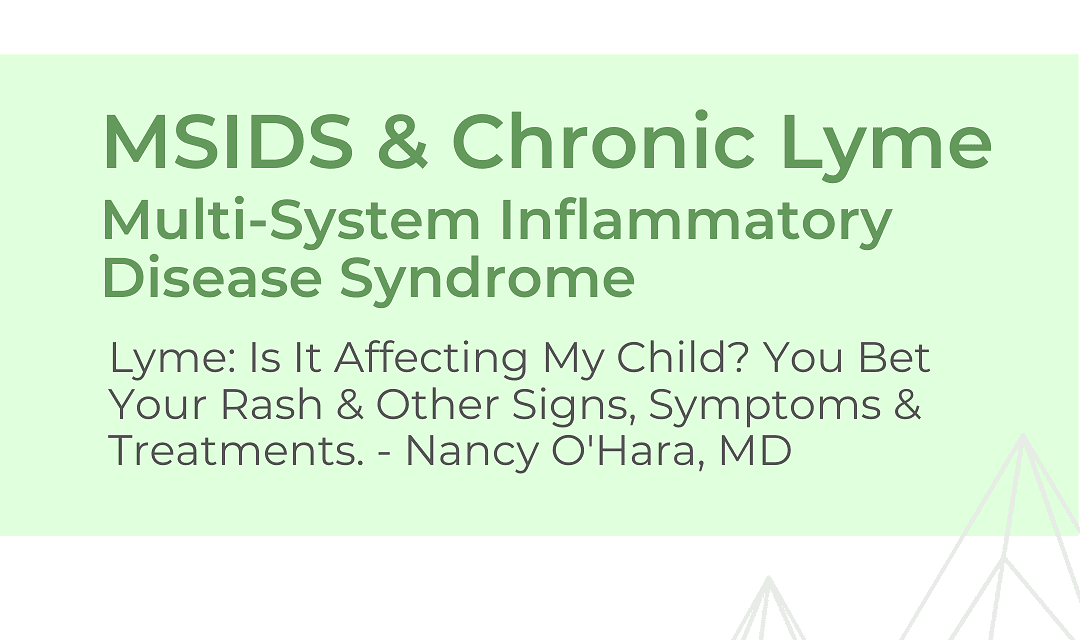MSIDS & Chronic Lyme Disease – Dr. O’Hara

Section 3: MSIDS & Chronic Lyme
Nancy O’Hara, MD, MPH, FAAP, a member of the ASPIRE Professional Advisory Board, presented on Lyme Disease, Tick-Borne Illness and Co-infections as part of the NECH Educational Series. This presentation is divided into 5 separate posts.
- Multi-Systemic Infectious Disease Syndrome
- Chronic Lyme – Autoimmune Disease
- Lyme Disease Fundamentals – Section Links
Multi-Systemic Infectious Disease Syndrome (MSIDS)
- Infections – Direct effect on cells
- Immune Dysfunction
- Toxicities and exposures (mold, environment, food)
- Allergies (environmental, food)
- Nutritional deficiencies
- Mitochondrial dysfunction
- Endocrine and metabolic abnormalities
It is important to think of Lyme as a multisystem disease. It’s not just the infection. There is a direct infectious effect on cells, but there’s also the immune dysfunction that goes along with it. There is the toxicity that may come from mold or Lyme itself or the foods that we’re eating. There’s a susceptibility to allergies, nutritional deficiencies, mitochondrial dysfunction, and it can also cause endocrine and metabolic problems. And of course, the gut is part of everything. All of these are part of the effects that we see from Lyme disease.
Multisystem Disease Treatment
Oral Antibiotics – Adults
- Doxycycline
- Amoxicillin
- Cefuroxime
- Azithromycin + Hydroxychloriquine
- Clarithromycin + Hydroxychloriquine
Oral Antibiotics – Children
- Amoxicillin
- Cefuroxime
- Doxycycline (older than 8 years old)
Chronic Lyme – Autoimmune Disease
- Antimicrobial Treatment – Minimum of 3 months
- Short-term failure rate 25-70%
- Need to be symptom free for at least 2 months
- Treatments we also do while on the anti-microbials
- Detox – Charcoal, Epsom Salts, Ibuprofen
- Biofilm protocols
- Liver protection – milk thistle, adaptogens
- Treat yeast – Probiotics, prebiotics
- Support of vitamin and mineral deficiencies
- Immunotherapy
- Anti-inflammatory diet
- Probiotics, prebiotics
- Aloe, curcumin, luteolin, quercetin, resveratrol
- Reishi mushrooms
- Herbals – oil of oregano, olive leaf extract, elderberry, astralagus and others
If we’re sure that it’s Lyme disease, the antimicrobial treatment needs to be a minimum of three months; the short-term failure rate can be over 70%. In addition, to the three months of treatment, we need to be symptom-free for at least two months. We also need to make sure we’re protecting the liver if they’re in on an antibiotic. Also, we need to make sure we are detoxifying, taking probiotics, herbs, or antifungals to treat yeast, that we are on an anti-inflammatory diet, anti-inflammatories, and herbals that help like olive leaf extract, oil of oregano, elderberry, astralagus. Those are all herbs that help to treat other infections like yeast and viruses that possibly have been part of what our patients are dealing with.
Chronic Lyme Treatment
- Flare vs Herx vs Die-Off
- Treat all phases of disease
- Cystic or Persister
- Metronidazole
- Grapefruit Seed Extract
- Hydroxychloriquine
- Tinidazole
- Tigecycline
- Daptomycin
- Intracellular
- Tetracycline
- Doxycycline
- Minocycline
- Azithromycin
- Clarithromycin
- Telithromycin
- Clindamycin
- Cell Wall
- Amoxicillin
- Amoxicillin-Clavulanate
- Cephalosporins
- Clindamycin
- Penems
- Vancomycin
- IM Bicillin (weekly in children for 6-12 months)
- IV Ceftriaxone
So whenever we’re treating, we always have to see is this child in a flare or having a herx reaction, or is it a die-off reaction? We also have to treat all phases of the disease. One phase is called the cystic phase or the persister phase. This is where hydroxychloroquine is used. We use a lot of Grapeseed extract and Flagyl because in children, some of these other medications can be very difficult for them to handle and are not recommended. Young children, we also treat them intracellularly. You’ll see us use one of the antibiotics listed. And we also treat the cell wall. Often we will use more than one antibiotic or more importantly, we will use herbals. See Dr. Wells & Herbals for Lyme.
Lyme Disease Fundamentals – Section Links
- Section 1: Lyme Disease Fundamentals
- Section 2: ILADS Lyme Disease Guidance
- Section 4: Lyme Treatment – Overview of Literature Review
- Section 5: Co-Infections Overview